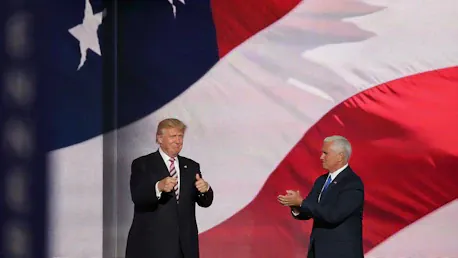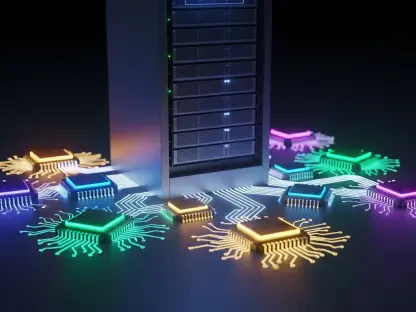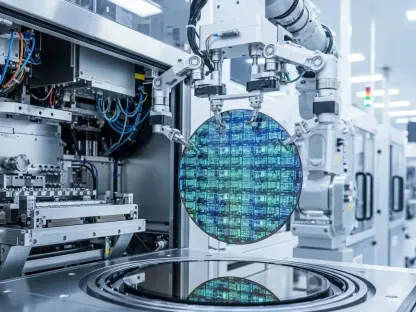The newly imposed tariffs by President Trump’s administration aim to rejuvenate domestic manufacturing jobs, offering hope of a resurgent American industrial landscape. These tariffs are intended to encourage companies to move their operations back to the United States, attracting manufacturing jobs that were previously outsourced to countries with lower labor costs. The debate among experts is heating up, with many questioning whether such policies will truly result in substantial job creation or if they will inadvertently accelerate automation within the industry.
Trump’s Tariff Policy and Its Goals
The Trump Administration has strongly defended the tariffs, asserting that they will foster the growth of manufacturing jobs by motivating companies to return their production activities to the United States. Press Secretary Karoline Leavitt has highlighted the expected positive impact on industries like automotive manufacturing, where the tariffs are anticipated to generate a significant shift in production away from lower-cost regions such as Vietnam. The goal is to invigorate American industries, creating a surge in employment opportunities as companies reshore their operations. This strategy seeks not only to bolster the economy but also to fortify national security by reducing dependency on foreign manufacturing supply chains.
The administration’s confidence is rooted in the belief that higher tariffs will deter companies from outsourcing jobs to cheaper labor markets. By increasing the cost of importing goods from nations with lower wages, they argue that domestic production will become more attractive, thus leading to the reopening of factories and revitalizing local economies. The automotive industry is particularly targeted, with hopes that increased tariffs will prompt auto manufacturers to prefer domestic production over international outsourcing. Such a shift could potentially result in numerous job opportunities, enhancing the industrial base of the United States, and providing a much-needed boost to the manufacturing sector.
Expert Opinions on Tariffs and Automation
However, many economists are skeptical about the efficacy of these tariffs in achieving their intended goals. Carl Benedikt Frey from Oxford University suggests that while the tariffs might initially appear favorable for job creation, the increased labor costs in the United States could prompt companies to explore alternative solutions, such as automation. With the cost-benefit analysis shifting due to higher labor expenses, investing in advanced AI and robotics may become a more viable and attractive option for manufacturers looking to maintain their competitive edge.
The prospect of automation as a byproduct of these tariffs raises concerns about the long-term implications for the American workforce. As companies face the financial pressures introduced by tariffs, automating production processes could offer a means to mitigate rising costs. While this approach could optimize efficiency and productivity, it may also reduce the number of available jobs, potentially counteracting the tariffs’ primary objective. This dichotomy highlights the complex interplay between economic policy and technological advancement, underscoring the need for careful consideration of the broader consequences of such measures.
Short-Term Versus Long-Term Impacts
While some experts predict that immediate changes may not be evident, the longer-term effects of the tariffs present a contentious issue. Nobel Prize-winning economist Daron Acemoglu suggests that the initial phase following the introduction of tariffs will likely be marked by significant disruptions. These disruptions could deter substantial capital investments in automation technology, at least in the short term. Companies may face a period of adaptation, grappling with increased production costs and logistical challenges as they realign their supply chains to domestic markets.
Over time, the economic pressures introduced by tariffs might drive companies to accelerate their investment in AI and robotics to ensure cost efficiency. This adaptation process may lead to increased automation, altering the landscape of the manufacturing sector. The reliance on AI and robotic technologies could become paramount, reshaping production processes and potentially reducing the reliance on human labor. Although this shift may enhance productivity, it also raises concerns about the displacement of workers and the need for significant retraining and reskilling efforts to prepare the existing workforce for a more technologically advanced industrial environment.
Historical Context and Technological Advancements
Drawing lessons from history, the 2018 tariffs under Trump’s administration did not manage to catalyze a significant increase in automation. Instead, they resulted in job losses and higher production costs due to decreased export competitiveness. The advancements in AI and robotics over recent years, however, have changed the dynamics. Innovations in general AI systems, along with improved robotics developed by companies like Boston Dynamics, have made automation a more plausible option. These technological breakthroughs have enhanced the adaptability and dexterity of robots, allowing for greater integration into various manufacturing processes.
Startups such as CivAI have played a crucial role in advancing the application of AI in robotics, streamlining the automation process for mid-sized manufacturing operations. By reducing the need for extensive investments in research and development, these companies have made it easier for manufacturers to adopt robotic solutions, thus lowering the barrier to entry. The current technological landscape presents an opportunity for manufacturers to leverage AI and robotics to enhance operational efficiency and productivity, even in the face of economic pressures introduced by tariffs. This trend reflects the broader shift towards a more automated industrial sector, where technology plays a pivotal role in shaping the future of manufacturing.
Ongoing Challenges and Economic Efficiency
Despite these advancements, significant challenges persist in the widespread adoption of automation. Acemoglu highlights the ongoing difficulties that robots encounter in adapting to complex and diverse tasks. While robots have made significant strides in performing repetitive and predefined tasks, the development of flexible robots capable of handling a broader range of activities is still in progress. Acemoglu estimates that practical implementation of such advanced robots may still be around a decade away, indicating that the transition towards a fully automated manufacturing sector will take time.
Moreover, the economic efficiency of automation remains a contentious issue. Erik Brynjolfsson from Stanford University argues that while automation can yield productivity gains, these benefits may not be sufficient to offset the losses incurred from disrupted supply chains and higher import costs. Tariffs inherently reduce economic efficiency by hindering global trade, making economic processes more cumbersome and less prosperous. The anticipated gains from automation must be weighed against the broader economic impacts, including potential job losses and the increased complexity of managing a more technologically driven manufacturing environment.
Balancing Optimism and Skepticism
The Trump Administration maintains a positive outlook on the role of AI in the labor market, advocating for policies that leverage AI to enhance worker productivity rather than displace jobs. Vice President JD Vance embodies this optimistic perspective, viewing AI as a tool for augmenting the capabilities of the workforce. This stance suggests a vision of a future where workers and AI systems collaborate to achieve greater efficiency and output, potentially transforming the nature of work and the industrial landscape.
However, historical precedents underscore the complexities and challenges associated with technological disruptions in the workforce. Labor historian Brian Merchant notes that economic downturns often present opportunities for companies to accelerate automation, leading to shifts in labor dynamics and reducing the leverage and protections afforded to workers. The nuanced interplay between economic policies, technological advancements, and labor market dynamics highlights the multifaceted impact of tariffs on the U.S. manufacturing sector. As companies navigate the pressures introduced by tariffs, the balance between job creation and automation will continue to evolve, shaping the future of American manufacturing.
Future Considerations for Manufacturing
The newly imposed tariffs by President Trump’s administration aim to rejuvenate domestic manufacturing jobs, infusing hope into the vision of a resurgent American industrial sector. These tariffs are strategically designed to motivate companies to relocate their operations back to the United States, thereby attracting manufacturing jobs that had previously been outsourced to countries known for their lower labor costs. This policy direction seeks to fortify the U.S. manufacturing base, potentially transforming the economic landscape. The move has sparked vigorous debate among experts, with some expressing optimism about the potential for significant job creation on American soil, while others question the overall effectiveness of such measures. Critics argue that these tariffs might inadvertently hasten the pace of automation within the industry, as companies look for ways to offset higher production costs. The critical debate stays lively, compelling policymakers, business leaders, and workers to consider the intricate balance between protectionism and innovation.









